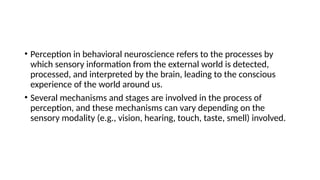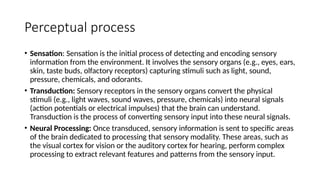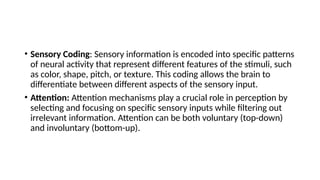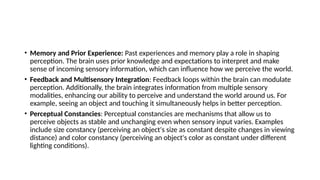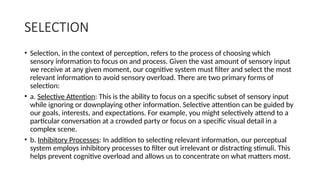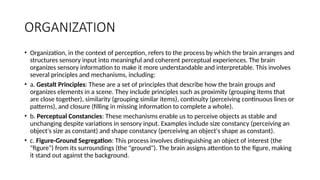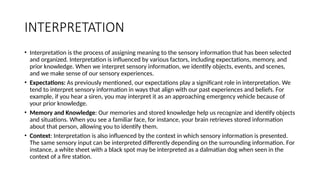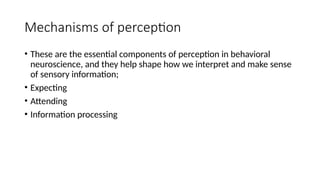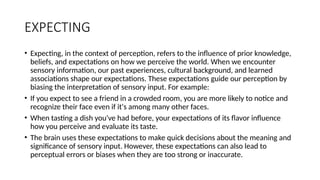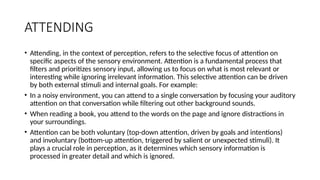PERCEPTION BEHAVIOURAL NEUROSCIENCE (1).pptx
- 1. PERCEPTION
- 2. ŌĆó Perception in behavioral neuroscience refers to the processes by which sensory information from the external world is detected, processed, and interpreted by the brain, leading to the conscious experience of the world around us. ŌĆó Several mechanisms and stages are involved in the process of perception, and these mechanisms can vary depending on the sensory modality (e.g., vision, hearing, touch, taste, smell) involved.
- 3. Perceptual process ŌĆó Sensation: Sensation is the initial process of detecting and encoding sensory information from the environment. It involves the sensory organs (e.g., eyes, ears, skin, taste buds, olfactory receptors) capturing stimuli such as light, sound, pressure, chemicals, and odorants. ŌĆó Transduction: Sensory receptors in the sensory organs convert the physical stimuli (e.g., light waves, sound waves, pressure, chemicals) into neural signals (action potentials or electrical impulses) that the brain can understand. Transduction is the process of converting sensory input into these neural signals. ŌĆó Neural Processing: Once transduced, sensory information is sent to specific areas of the brain dedicated to processing that sensory modality. These areas, such as the visual cortex for vision or the auditory cortex for hearing, perform complex processing to extract relevant features and patterns from the sensory input.
- 4. ŌĆó Sensory Coding: Sensory information is encoded into specific patterns of neural activity that represent different features of the stimuli, such as color, shape, pitch, or texture. This coding allows the brain to differentiate between different aspects of the sensory input. ŌĆó Attention: Attention mechanisms play a crucial role in perception by selecting and focusing on specific sensory inputs while filtering out irrelevant information. Attention can be both voluntary (top-down) and involuntary (bottom-up).
- 5. ŌĆó Memory and Prior Experience: Past experiences and memory play a role in shaping perception. The brain uses prior knowledge and expectations to interpret and make sense of incoming sensory information, which can influence how we perceive the world. ŌĆó Feedback and Multisensory Integration: Feedback loops within the brain can modulate perception. Additionally, the brain integrates information from multiple sensory modalities, enhancing our ability to perceive and understand the world around us. For example, seeing an object and touching it simultaneously helps in better perception. ŌĆó Perceptual Constancies: Perceptual constancies are mechanisms that allow us to perceive objects as stable and unchanging even when sensory input varies. Examples include size constancy (perceiving an object's size as constant despite changes in viewing distance) and color constancy (perceiving an object's color as constant under different lighting conditions).
- 6. Key concepts of perception ŌĆó SELECTION ŌĆó ORGANIZATION ŌĆó INTERPRETATION
- 7. SELECTION ŌĆó Selection, in the context of perception, refers to the process of choosing which sensory information to focus on and process. Given the vast amount of sensory input we receive at any given moment, our cognitive system must filter and select the most relevant information to avoid sensory overload. There are two primary forms of selection: ŌĆó a. Selective Attention: This is the ability to focus on a specific subset of sensory input while ignoring or downplaying other information. Selective attention can be guided by our goals, interests, and expectations. For example, you might selectively attend to a particular conversation at a crowded party or focus on a specific visual detail in a complex scene. ŌĆó b. Inhibitory Processes: In addition to selecting relevant information, our perceptual system employs inhibitory processes to filter out irrelevant or distracting stimuli. This helps prevent cognitive overload and allows us to concentrate on what matters most.
- 8. ORGANIZATION ŌĆó Organization, in the context of perception, refers to the process by which the brain arranges and structures sensory input into meaningful and coherent perceptual experiences. The brain organizes sensory information to make it more understandable and interpretable. This involves several principles and mechanisms, including: ŌĆó a. Gestalt Principles: These are a set of principles that describe how the brain groups and organizes elements in a scene. They include principles such as proximity (grouping items that are close together), similarity (grouping similar items), continuity (perceiving continuous lines or patterns), and closure (filling in missing information to complete a whole). ŌĆó b. Perceptual Constancies: These mechanisms enable us to perceive objects as stable and unchanging despite variations in sensory input. Examples include size constancy (perceiving an object's size as constant) and shape constancy (perceiving an object's shape as constant). ŌĆó c. Figure-Ground Segregation: This process involves distinguishing an object of interest (the "figure") from its surroundings (the "ground"). The brain assigns attention to the figure, making it stand out against the background.
- 9. INTERPRETATION ŌĆó Interpretation is the process of assigning meaning to the sensory information that has been selected and organized. Interpretation is influenced by various factors, including expectations, memory, and prior knowledge. When we interpret sensory information, we identify objects, events, and scenes, and we make sense of our sensory experiences. ŌĆó Expectations: As previously mentioned, our expectations play a significant role in interpretation. We tend to interpret sensory information in ways that align with our past experiences and beliefs. For example, if you hear a siren, you may interpret it as an approaching emergency vehicle because of your prior knowledge. ŌĆó Memory and Knowledge: Our memories and stored knowledge help us recognize and identify objects and situations. When you see a familiar face, for instance, your brain retrieves stored information about that person, allowing you to identify them. ŌĆó Context: Interpretation is also influenced by the context in which sensory information is presented. The same sensory input can be interpreted differently depending on the surrounding information. For instance, a white sheet with a black spot may be interpreted as a dalmatian dog when seen in the context of a fire station.
- 10. Mechanisms of perception ŌĆó These are the essential components of perception in behavioral neuroscience, and they help shape how we interpret and make sense of sensory information; ŌĆó Expecting ŌĆó Attending ŌĆó Information processing
- 11. EXPECTING ŌĆó Expecting, in the context of perception, refers to the influence of prior knowledge, beliefs, and expectations on how we perceive the world. When we encounter sensory information, our past experiences, cultural background, and learned associations shape our expectations. These expectations guide our perception by biasing the interpretation of sensory input. For example: ŌĆó If you expect to see a friend in a crowded room, you are more likely to notice and recognize their face even if it's among many other faces. ŌĆó When tasting a dish you've had before, your expectations of its flavor influence how you perceive and evaluate its taste. ŌĆó The brain uses these expectations to make quick decisions about the meaning and significance of sensory input. However, these expectations can also lead to perceptual errors or biases when they are too strong or inaccurate.
- 12. ATTENDING ŌĆó Attending, in the context of perception, refers to the selective focus of attention on specific aspects of the sensory environment. Attention is a fundamental process that filters and prioritizes sensory input, allowing us to focus on what is most relevant or interesting while ignoring irrelevant information. This selective attention can be driven by both external stimuli and internal goals. For example: ŌĆó In a noisy environment, you can attend to a single conversation by focusing your auditory attention on that conversation while filtering out other background sounds. ŌĆó When reading a book, you attend to the words on the page and ignore distractions in your surroundings. ŌĆó Attention can be both voluntary (top-down attention, driven by goals and intentions) and involuntary (bottom-up attention, triggered by salient or unexpected stimuli). It plays a crucial role in perception, as it determines which sensory information is processed in greater detail and which is ignored.
- 13. INFORMATION PROCESSING ŌĆó Information processing in perception refers to the sequence of cognitive operations that occur as the brain interprets and makes sense of sensory input. This processing involves various stages, including: ŌĆó Sensory coding: Sensory input is converted into neural signals that represent different features of the stimuli, such as color, shape, texture, or pitch. ŌĆó Feature extraction: The brain extracts relevant features from sensory input and identifies patterns and objects. ŌĆó Integration and perceptual organization: Information from different sensory modalities is integrated, and the brain organizes elements into a coherent perceptual experience. ŌĆó Memory and recognition: The brain compares the processed sensory information with stored representations in memory to recognize and identify objects and scenes. ŌĆó Information processing is influenced by expectations and attention, as these factors guide the allocation of cognitive resources and the interpretation of sensory data. Additionally, perceptual mechanisms, such as perceptual constancies and Gestalt principles, play a role in how the brain processes and organizes sensory information to form a stable and meaningful perception.

